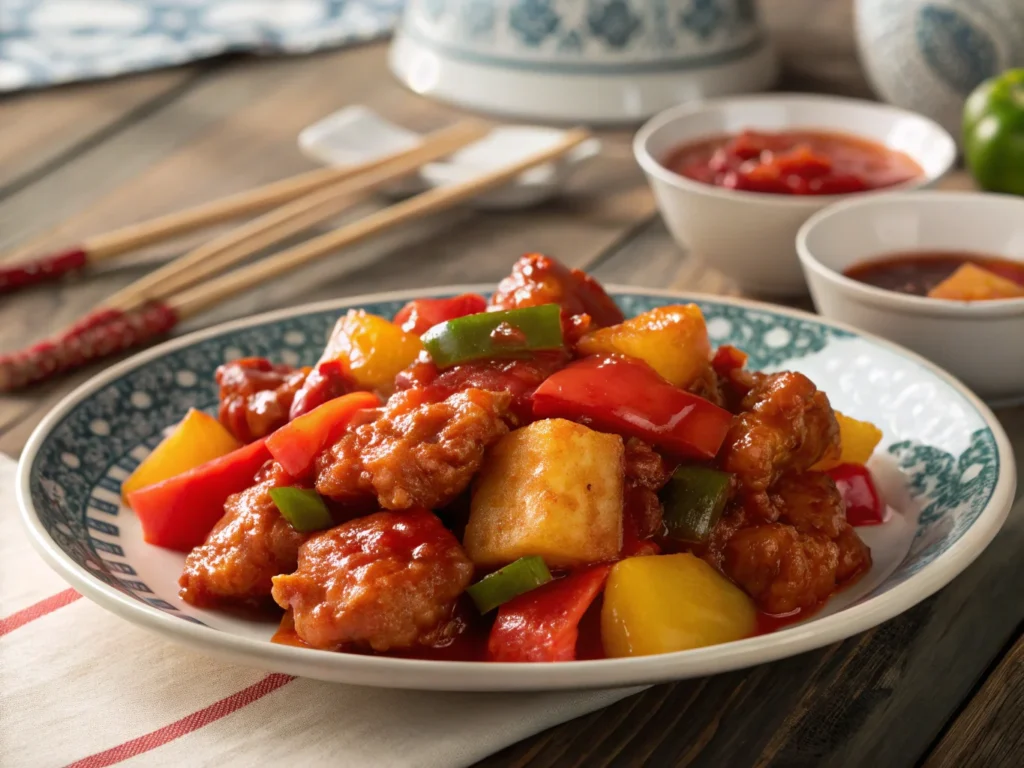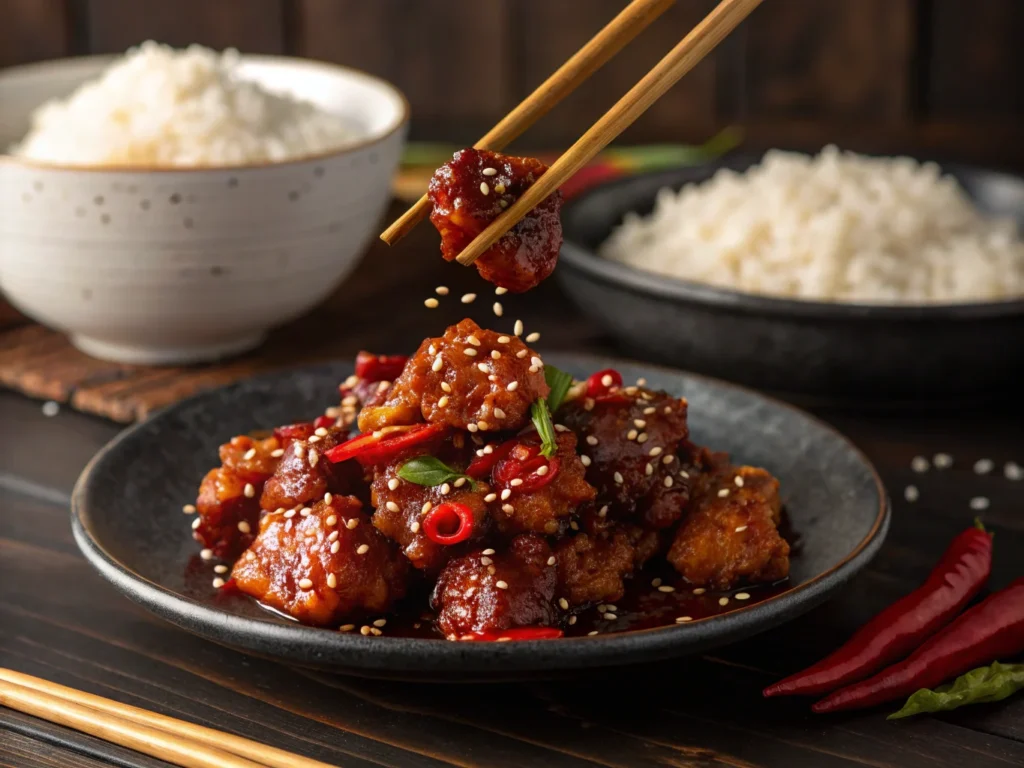Introduction
Chinese-American cuisine has become a staple in many households and restaurants across the United States. Dishes like General Tso’s chicken and sweet and sour chicken are among the most popular choices. However, while both feature crispy, battered chicken coated in flavorful sauces, their taste profiles and histories set them apart.
Many people wonder, what’s the difference between General Tso chicken and sweet and sour chicken? The answer lies in their origins, ingredients, and cooking methods. Sweet and sour chicken delivers a tangy, fruity taste, while General Tso’s chicken carries a sweet, spicy, and savory balance. Understanding their differences can help diners appreciate the unique aspects of each dish.
This article dives into the backgrounds, ingredients, and cooking styles of both dishes, offering a comprehensive look at what makes them distinct.
The Popularity of Chinese-American Cuisine
Chinese-American cuisine has a long history in the United States, dating back to the 19th century when Chinese immigrants first introduced their cooking techniques. Over time, dishes evolved to cater to American palates, resulting in new recipes that blended traditional Chinese flavors with Western ingredients.
Popular dishes such as orange chicken, Mongolian beef, and General Tso’s chicken have become synonymous with takeout culture. Many of these dishes, including sweet and sour chicken, feature a mix of crispy textures and bold, flavorful sauces. This combination appeals to a wide audience, making them some of the most-ordered items in Chinese restaurants.
Despite their popularity, many of these dishes do not exist in the same form in China. Instead, they are Westernized adaptations of traditional flavors. Because of this, many people are curious about the authenticity and differences between various Chinese-American dishes.
Spotlight on Two Favorites
When choosing between General Tso’s chicken and sweet and sour chicken, diners often base their decision on taste preferences. Both dishes offer crispy fried chicken, but their sauces create dramatically different flavors.
- Sweet and sour chicken features a sauce made with vinegar, sugar, and fruit juices, creating a balance of tangy and sweet flavors. The dish often includes pineapple, bell peppers, and onions for added texture and freshness.
- General Tso’s chicken has a spicy-sweet glaze made from soy sauce, garlic, ginger, and dried chilies. The sauce is thicker and more savory compared to sweet and sour sauce, with a slight heat that lingers.
Both dishes have become staples in Chinese-American cuisine, often served with rice or vegetables. While their ingredients overlap, their flavor profiles and cultural backgrounds make them distinct from one another.
Origins and History
The Birth of Sweet and Sour Chicken
Traditional Roots in Chinese Cuisine
The concept of sweet and sour flavors has existed in Chinese cuisine for centuries. Early Chinese recipes combined vinegar and sugar to create a balanced taste that complemented meats like pork and fish. This flavor profile was particularly common in Cantonese cuisine, which emphasizes mild, slightly sweet flavors.
Dishes like sweet and sour pork were among the first to use this combination. The sauce was originally made with black vinegar, honey, and fruit-based ingredients like hawthorn or preserved plums. Over time, as international trade introduced new ingredients, different regions developed their own versions of sweet and sour dishes.
While sweet and sour pork remained a staple in China, variations using chicken, shrimp, and beef emerged as Chinese cuisine spread globally. This set the stage for the Western adaptation of sweet and sour chicken, which became a restaurant favorite.
Adaptation in Western Countries
When Chinese immigrants arrived in the United States, they adapted their traditional recipes to suit the American palate. In the case of sweet and sour chicken, the sauce evolved to include ketchup, sugar, and pineapple juice, giving it a fruitier and more vibrant red color.
Unlike the lightly battered, wok-fried pork found in traditional Chinese cooking, Americanized sweet and sour chicken is often deep-fried in thick batter to create a crispier texture. The addition of bell peppers, onions, and pineapple chunks enhanced the dish’s visual appeal and added extra layers of sweetness.
By the mid-20th century, sweet and sour chicken had become a popular dish in Chinese-American restaurants. Its bright red sauce and combination of sweet, tangy flavors made it stand out, especially among customers looking for a less spicy option.
The Story Behind General Tso’s Chicken
Creation by Chef Peng Chang-kuei
General Tso’s chicken has a fascinating origin that differs significantly from that of sweet and sour chicken. Unlike many Chinese-American dishes, it was not originally created in China. Instead, it was invented by Chef Peng Chang-kuei, a Taiwanese chef who trained in Hunan cuisine.
In the 1950s, Chef Peng, who had fled to Taiwan during China’s civil war, wanted to create a dish that represented Hunan flavors while appealing to his Taiwanese audience. He crafted a dish using deep-fried chicken, soy sauce, garlic, and a slightly sweet glaze, naming it after General Tso Tsung-t’ang, a 19th-century Chinese military leader.
Although the dish was inspired by Hunan cuisine, it did not follow traditional Hunanese cooking, which is typically much spicier and lacks sweetness. Instead, it was a completely new creation that blended savory, sweet, and mildly spicy flavors.
Introduction to American Diners
Despite its success in Taiwan, General Tso’s chicken did not become widely known until Chef Peng brought it to the United States in the 1970s. When he opened a restaurant in New York City, his dish quickly gained popularity among American diners.
However, as the dish spread across Chinese-American restaurants, chefs modified the recipe to make it sweeter and less spicy to match local tastes. Over time, the version found in most Chinese takeout restaurants became milder and more sugary, with some variations even omitting the dried chilies.
By the 1980s, General Tso’s chicken had cemented its place as a Chinese-American classic, often served alongside other Americanized favorites like lo mein and fried rice. Today, it remains a top choice for those who enjoy rich, bold flavors with a slightly spicy kick.
Flavor Profiles and Ingredients
Sweet and Sour Chicken
Key Ingredients
The foundation of sweet and sour chicken lies in its combination of crispy battered chicken and a vibrant, tangy sauce. While the exact recipe can vary, the core ingredients remain consistent across different versions.
- Chicken breast – Most recipes use boneless, skinless chicken breast, cut into bite-sized pieces. This lean cut absorbs the sauce well while maintaining a tender texture.
- Bell peppers – Red, green, and yellow bell peppers add color, crunch, and a mild sweetness, complementing the sauce’s tangy profile.
- Pineapple chunks – Fresh or canned pineapple contributes natural sweetness and acidity, which balances the vinegar-based sauce.
- Sweet and sour sauce – The signature sauce combines ketchup, rice vinegar, sugar, and soy sauce, creating a glossy, bright-red coating that clings to the fried chicken.
Additional ingredients like onions, garlic, and cornstarch help enhance the dish’s depth of flavor and texture. This combination gives sweet and sour chicken its unmistakable taste.

Taste and Texture
The most noticeable aspect of sweet and sour chicken is its bold, tangy-sweet flavor. The ketchup-based sauce delivers a fruity, slightly acidic taste, while sugar and pineapple juice contribute natural sweetness. Rice vinegar enhances the tanginess, making the sauce bright and refreshing rather than overly sugary.
When fried correctly, the chicken pieces remain crispy, even after being coated in sauce. The light, golden-brown batter provides a delicate crunch, contrasting with the smooth, glossy sauce. Meanwhile, the bell peppers and onions add a slight crunch, preventing the dish from feeling too soft.
The overall flavor profile is fruity, tangy, and mildly sweet, making it an excellent choice for those who prefer milder, non-spicy dishes. Unlike General Tso’s chicken, which carries a savory and spicy edge, sweet and sour chicken focuses on tangy brightness and tropical sweetness.
General Tso’s Chicken
Key Ingredients
General Tso’s chicken features deep-fried, crispy chicken coated in a sweet, spicy, and umami-rich sauce. Unlike sweet and sour chicken, which emphasizes fruity notes, General Tso’s chicken leans toward savory complexity with a mild heat.
- Chicken thighs – This dish typically uses boneless, skinless chicken thighs, which have more fat and tenderness than chicken breast. The higher fat content prevents the chicken from drying out.
- Dried chilies – These add heat and smoky depth to the sauce, giving the dish a subtle spiciness. Some versions use red pepper flakes instead.
- Broccoli – Though not always included in traditional recipes, steamed broccoli is commonly served alongside General Tso’s chicken in American Chinese restaurants.
- Savory sauce – The sauce consists of soy sauce, hoisin sauce, garlic, ginger, sugar, and rice vinegar, creating a balanced mix of sweet, spicy, and umami flavors.
While both dishes use fried chicken with a sweet sauce, General Tso’s chicken incorporates spicy and umami elements, making it bolder and more complex.
Taste and Texture

The first thing you notice when eating General Tso’s chicken is its crispy, slightly chewy texture, followed by a burst of sweet, savory, and mildly spicy flavors.
The sauce has a rich, deep sweetness from brown sugar and hoisin sauce, contrasted with garlic, ginger, and dried chilies for heat and depth. Unlike sweet and sour chicken, which leans on fruity tartness, General Tso’s chicken has a more robust, caramelized glaze with a hint of smokiness.
The fried chicken pieces are thicker and crunchier, thanks to a cornstarch-based coating. The sauce clings to the crispy exterior without making it soggy, creating a satisfying bite with a slight chewiness.
In comparison, what’s the difference between General Tso chicken and sweet and sour chicken? While both dishes are sweet and crispy, General Tso’s chicken has a more complex balance of sweet, spicy, and umami flavors, whereas sweet and sour chicken focuses on fruity tartness and light sweetness.
Preparation Methods
Cooking Sweet and Sour Chicken
Batter and Frying Technique
Achieving the perfectly crispy texture in sweet and sour chicken starts with the battering and frying process. Unlike General Tso’s chicken, which uses a thinner cornstarch coating, sweet and sour chicken features a thicker, fluffier batter.
- Step 1: Coat the chicken – Chicken breast pieces are dipped in an egg-based batter made with flour, cornstarch, and baking powder. This creates a light yet crunchy crust.
- Step 2: Fry until golden – The battered chicken is deep-fried at 350°F until it turns golden brown and crispy. The high temperature ensures that the outside crisps up quickly, while the inside stays moist and tender.
This method results in a thicker, fluffier crust compared to General Tso’s chicken, which has a thinner, crunchier coating.
Sauce Preparation
The sweet and sour sauce is the defining feature of this dish. It is made by combining ketchup, rice vinegar, sugar, soy sauce, and pineapple juice in a pan and simmering until thickened.
- Ketchup and sugar provide sweetness and a vibrant red color.
- Rice vinegar adds tanginess and acidity, balancing the sweetness.
- Cornstarch slurry is used to thicken the sauce so it clings to the fried chicken.
Once the sauce is ready, the fried chicken is tossed in the pan, allowing it to absorb the tangy flavors. The final dish has a glossy, thick coating that enhances its crispiness and sweet-tart flavor.
Cooking General Tso’s Chicken
Marination and Frying Technique
Unlike sweet and sour chicken, which uses a thicker batter, General Tso’s chicken is coated in a light cornstarch mixture, resulting in a crispier, crunchier texture.
- Step 1: Marinate the chicken – Chicken thighs are marinated in soy sauce, garlic, and egg whites, which helps tenderize the meat and enhance its flavor.
- Step 2: Coat with cornstarch – Before frying, the marinated chicken is dusted with cornstarch, creating a thin, crispy crust when fried.
- Step 3: Fry until crispy – The chicken is deep-fried at 375°F until golden brown. Since the coating is thinner, it stays crispy even after being tossed in sauce.
This lighter, crispier crust contrasts with the thicker, fluffier batter of sweet and sour chicken, making it distinct in texture.
Sauce Preparation
The savory-spicy sauce is what gives General Tso’s chicken its unique depth of flavor. It combines sweetness, spice, and umami for a rich, caramelized glaze.
- Soy sauce and hoisin sauce provide savory umami flavors.
- Brown sugar and honey add sweetness and thickness.
- Rice vinegar balances the sauce with mild acidity.
- Dried chilies and garlic introduce heat and depth.
Once the sauce is ready, the crispy chicken is tossed in the pan, allowing it to absorb the sweet, spicy, and umami flavors.
When comparing what’s the difference between General Tso chicken and sweet and sour chicken?, the key distinction lies in their sauces and coatings. Sweet and sour chicken is tangy and fruity with a thicker batter, whereas General Tso’s chicken is savory, slightly spicy, and crispier.
Cultural Impact and Variations
Influence on Western Palates
Both General Tso’s chicken and sweet and sour chicken have been heavily influenced by Western preferences. When Chinese immigrants brought their culinary traditions to the United States, they adapted their dishes to cater to American tastes.
- Sweeter flavors – Traditional Chinese cuisine often balances salty, sour, bitter, and spicy elements. However, American palates favor sweeter profiles, leading to increased sugar content in these dishes.
- Thicker sauces – Authentic Chinese sauces are typically lighter and less sticky, whereas American versions use cornstarch and sugar to create a glossy, thick coating that clings to fried chicken.
- More frying, less steaming – Chinese cuisine features many steamed, braised, or stir-fried dishes, but Americanized versions favor deep-frying, enhancing the crispy texture.
Over time, these changes helped General Tso’s chicken and sweet and sour chicken become staples of American Chinese cuisine, making them popular takeout choices.
Regional Variations
While both dishes are primarily associated with Chinese-American cuisine, different regions have put their own spin on them. These variations range from ingredient substitutions to differences in spice levels.
- China – Authentic sweet and sour dishes exist, but they typically use pork rather than chicken. The sauce is less sweet, relying more on vinegar-based tanginess. General Tso’s chicken, however, is not commonly eaten in China.
- Taiwan – Since General Tso’s chicken was created by a Taiwanese chef, Taiwan’s version is less sweet, spicier, and closer to Hunan cuisine.
- Canada – Some versions of sweet and sour chicken in Canada include breaded chicken balls with a side of dipping sauce rather than fully coating the chicken in sauce.
- The UK and Australia – These countries often use brighter red sweet and sour sauce, sometimes with extra tomato paste for a stronger tangy flavor.
These regional twists show how General Tso’s chicken and sweet and sour chicken have evolved based on local preferences while maintaining their core flavors.
Frequently Asked Questions (FAQs)
Common Queries About General Tso’s and Sweet and Sour Chicken
What is the difference between General Tso’s and sweet and sour chicken?
What’s the difference between General Tso chicken and sweet and sour chicken? The key differences lie in their flavor, sauce, and spice levels.
- General Tso’s chicken has a savory, slightly spicy sauce with soy sauce, garlic, ginger, and dried chilies. It is less sweet but has a deep, caramelized glaze.
- Sweet and sour chicken focuses on fruity sweetness and tangy flavors. Its sauce is made with ketchup, sugar, vinegar, and pineapple juice, creating a bright, sticky glaze.
Additionally, General Tso’s chicken is typically spicier and less fruity, while sweet and sour chicken leans toward mild, sweet, and tangy flavors.
Is General Tso’s chicken spicy or sweet?
General Tso’s chicken strikes a balance between sweet and spicy flavors. The brown sugar and hoisin sauce provide sweetness, while dried chilies and garlic add a mild heat.
However, compared to traditional Hunan cuisine, which can be much spicier, the Americanized version is relatively mild. Some restaurants adjust the heat level based on customer preference, making it either spicier or milder.
For those who enjoy a hint of spice but not overwhelming heat, General Tso’s chicken is a great option. It is bolder than sweet and sour chicken but less fiery than authentic Hunan dishes.
Do they eat sweet and sour chicken in China?
While sweet and sour flavors are present in traditional Chinese cuisine, the version known in the West is not commonly eaten in China. Instead, sweet and sour pork is the more traditional dish.
- The Chinese version typically includes pork ribs or fillets, less sugar, and a more balanced tangy sauce.
- Americanized sweet and sour chicken is sweeter, redder, and often uses pineapple, which is uncommon in China.
If you visit China, you might find sweet and sour pork or fish cooked in a tangy sauce, but you are unlikely to see the deep-fried battered chicken version found in American takeout restaurants.
Is General Tso’s chicken just orange chicken?
No, General Tso’s chicken and orange chicken are two distinct dishes, though they share some similarities.
- Orange chicken is sweeter and citrus-based, using orange juice or zest to create a fruity, tangy flavor.
- General Tso’s chicken has a more complex, savory taste, with garlic, soy sauce, hoisin sauce, and dried chilies.
Both dishes feature crispy fried chicken with a thick sauce, but the main difference is that orange chicken focuses on citrusy sweetness, while General Tso’s chicken balances sweet, savory, and spicy elements.
Conclusion
Summarizing the Key Differences
What’s the difference between General Tso chicken and sweet and sour chicken? The key differences come down to flavor, sauce, and spice level.
- Sweet and sour chicken is mild, fruity, and tangy, featuring a bright red sauce with pineapple and vinegar.
- General Tso’s chicken is richer, spicier, and more savory, with a dark, caramelized glaze and dried chilies.
While both dishes are crispy, battered chicken options, their sauce ingredients and flavor profiles create distinct taste experiences.

Encouragement to Explore Both Dishes
For those who lFor those who love bold, slightly spicy flavors, General Tso’s chicken is a great choice. On the other hand, if you prefer mild, tangy, and fruity flavors, sweet and sour chicken is the way to go.
Many diners wonder, what’s the difference between General Tso chicken and sweet and sour chicken? The best way to find out is to try both! Since each dish has a unique combination of flavors and textures, experiencing them side by side can help you decide which one suits your taste best.
Whether you order takeout or make them at home, these Chinese-American classics showcase two distinct flavor profiles. So next time you’re craving crispy, saucy chicken, consider what’s the difference between General Tso chicken and sweet and sour chicken, and choose the dish that matches your mood.ove bold, slightly spicy flavors, General Tso’s chicken is a great choice. If you prefer mild, tangy, and fruity dishes, sweet and sour chicken is the way to go.
Since both dishes have unique flavors and textures, trying both can help you decide which one suits your taste buds best. Whether you order them from a takeout restaurant or make them at home, these Chinese-American classics offer a delicious fusion of flavors worth exploring.





